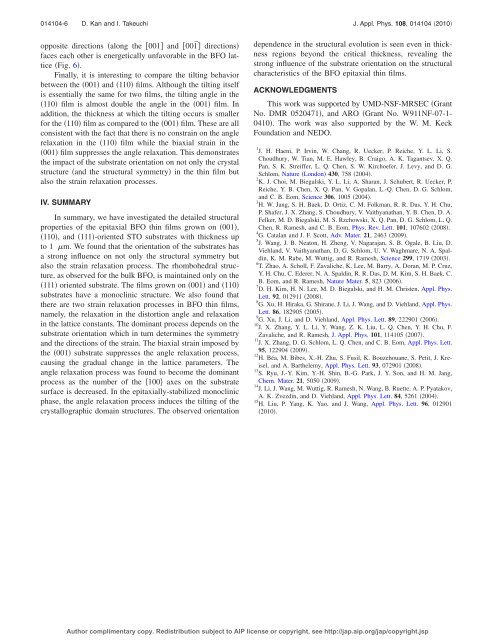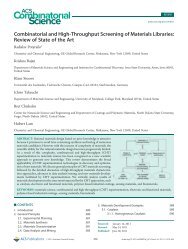Effect of substrate orientation on lattice relaxation of epitaxial ...
Effect of substrate orientation on lattice relaxation of epitaxial ...
Effect of substrate orientation on lattice relaxation of epitaxial ...
You also want an ePaper? Increase the reach of your titles
YUMPU automatically turns print PDFs into web optimized ePapers that Google loves.
014104-6 D. Kan and I. Takeuchi J. Appl. Phys. 108, 014104 2010<br />
opposite directi<strong>on</strong>s al<strong>on</strong>g the 001 and 001¯ directi<strong>on</strong>s<br />
faces each other is energetically unfavorable in the BFO <strong>lattice</strong><br />
Fig. 6.<br />
Finally, it is interesting to compare the tilting behavior<br />
between the 001 and 110 films. Although the tilting itself<br />
is essentially the same for two films, the tilting angle in the<br />
110 film is almost double the angle in the 001 film. In<br />
additi<strong>on</strong>, the thickness at which the tilting occurs is smaller<br />
for the 110 film as compared to the 001 film. These are all<br />
c<strong>on</strong>sistent with the fact that there is no c<strong>on</strong>strain <strong>on</strong> the angle<br />
relaxati<strong>on</strong> in the 110 film while the biaxial strain in the<br />
001 film suppresses the angle relaxati<strong>on</strong>. This dem<strong>on</strong>strates<br />
the impact <str<strong>on</strong>g>of</str<strong>on</strong>g> the <str<strong>on</strong>g>substrate</str<strong>on</strong>g> <str<strong>on</strong>g>orientati<strong>on</strong></str<strong>on</strong>g> <strong>on</strong> not <strong>on</strong>ly the crystal<br />
structure and the structural symmetry in the thin film but<br />
also the strain relaxati<strong>on</strong> processes.<br />
IV. SUMMARY<br />
In summary, we have investigated the detailed structural<br />
properties <str<strong>on</strong>g>of</str<strong>on</strong>g> the <strong>epitaxial</strong> BFO thin films grown <strong>on</strong> 001,<br />
110, and 111-oriented STO <str<strong>on</strong>g>substrate</str<strong>on</strong>g>s with thickness up<br />
to 1 m. We found that the <str<strong>on</strong>g>orientati<strong>on</strong></str<strong>on</strong>g> <str<strong>on</strong>g>of</str<strong>on</strong>g> the <str<strong>on</strong>g>substrate</str<strong>on</strong>g>s has<br />
a str<strong>on</strong>g influence <strong>on</strong> not <strong>on</strong>ly the structural symmetry but<br />
also the strain relaxati<strong>on</strong> process. The rhombohedral structure,<br />
as observed for the bulk BFO, is maintained <strong>on</strong>ly <strong>on</strong> the<br />
111 oriented <str<strong>on</strong>g>substrate</str<strong>on</strong>g>. The films grown <strong>on</strong> 001 and 110<br />
<str<strong>on</strong>g>substrate</str<strong>on</strong>g>s have a m<strong>on</strong>oclinic structure. We also found that<br />
there are two strain relaxati<strong>on</strong> processes in BFO thin films,<br />
namely, the relaxati<strong>on</strong> in the distorti<strong>on</strong> angle and relaxati<strong>on</strong><br />
in the <strong>lattice</strong> c<strong>on</strong>stants. The dominant process depends <strong>on</strong> the<br />
<str<strong>on</strong>g>substrate</str<strong>on</strong>g> <str<strong>on</strong>g>orientati<strong>on</strong></str<strong>on</strong>g> which in turn determines the symmetry<br />
and the directi<strong>on</strong>s <str<strong>on</strong>g>of</str<strong>on</strong>g> the strain. The biaxial strain imposed by<br />
the 001 <str<strong>on</strong>g>substrate</str<strong>on</strong>g> suppresses the angle relaxati<strong>on</strong> process,<br />
causing the gradual change in the <strong>lattice</strong> parameters. The<br />
angle relaxati<strong>on</strong> process was found to become the dominant<br />
process as the number <str<strong>on</strong>g>of</str<strong>on</strong>g> the 100 axes <strong>on</strong> the <str<strong>on</strong>g>substrate</str<strong>on</strong>g><br />
surface is decreased. In the <strong>epitaxial</strong>ly-stabilized m<strong>on</strong>oclinic<br />
phase, the angle relaxati<strong>on</strong> process induces the tilting <str<strong>on</strong>g>of</str<strong>on</strong>g> the<br />
crystallographic domain structures. The observed <str<strong>on</strong>g>orientati<strong>on</strong></str<strong>on</strong>g><br />
dependence in the structural evoluti<strong>on</strong> is seen even in thickness<br />
regi<strong>on</strong>s bey<strong>on</strong>d the critical thickness, revealing the<br />
str<strong>on</strong>g influence <str<strong>on</strong>g>of</str<strong>on</strong>g> the <str<strong>on</strong>g>substrate</str<strong>on</strong>g> <str<strong>on</strong>g>orientati<strong>on</strong></str<strong>on</strong>g> <strong>on</strong> the structural<br />
characteristics <str<strong>on</strong>g>of</str<strong>on</strong>g> the BFO <strong>epitaxial</strong> thin films.<br />
ACKNOWLEDGMENTS<br />
This work was supported by UMD-NSF-MRSEC Grant<br />
No. DMR 0520471, and ARO Grant No. W911NF-07-1-<br />
0410. The work was also supported by the W. M. Keck<br />
Foundati<strong>on</strong> and NEDO.<br />
1 J. H. Haeni, P. Irvin, W. Chang, R. Uecker, P. Reiche, Y. L. Li, S.<br />
Choudhury, W. Tian, M. E. Hawley, B. Craigo, A. K. Tagantsev, X. Q.<br />
Pan, S. K. Streiffer, L. Q. Chen, S. W. Kirchoefer, J. Levy, and D. G.<br />
Schlom, Nature L<strong>on</strong>d<strong>on</strong> 430, 758 2004.<br />
2 K. J. Choi, M. Biegalski, Y. L. Li, A. Sharan, J. Schubert, R. Uecker, P.<br />
Reiche, Y. B. Chen, X. Q. Pan, V. Gopalan, L.-Q. Chen, D. G. Schlom,<br />
and C. B. Eom, Science 306, 1005 2004.<br />
3 H. W. Jang, S. H. Baek, D. Ortiz, C. M. Folkman, R. R. Das, Y. H. Chu,<br />
P. Shafer, J. X. Zhang, S. Choudhury, V. Vaithyanathan, Y. B. Chen, D. A.<br />
Felker, M. D. Biegalski, M. S. Rzchowski, X. Q. Pan, D. G. Schlom, L. Q.<br />
Chen, R. Ramesh, and C. B. Eom, Phys. Rev. Lett. 101, 107602 2008.<br />
4 G. Catalan and J. F. Scott, Adv. Mater. 21, 24632009.<br />
5 J. Wang, J. B. Neat<strong>on</strong>, H. Zheng, V. Nagarajan, S. B. Ogale, B. Liu, D.<br />
Viehland, V. Vaithyanathan, D. G. Schlom, U. V. Waghmare, N. A. Spaldin,<br />
K. M. Rabe, M. Wuttig, and R. Ramesh, Science 299, 1719 2003.<br />
6 T. Zhao, A. Scholl, F. Zavaliche, K. Lee, M. Barry, A. Doran, M. P. Cruz,<br />
Y. H. Chu, C. Ederer, N. A. Spaldin, R. R. Das, D. M. Kim, S. H. Baek, C.<br />
B. Eom, and R. Ramesh, Nature Mater. 5, 823 2006.<br />
7 D. H. Kim, H. N. Lee, M. D. Biegalski, and H. M. Christen, Appl. Phys.<br />
Lett. 92, 012911 2008.<br />
8 G. Xu, H. Hiraka, G. Shirane, J. Li, J. Wang, and D. Viehland, Appl. Phys.<br />
Lett. 86, 182905 2005.<br />
9 G. Xu, J. Li, and D. Viehland, Appl. Phys. Lett. 89, 222901 2006.<br />
10 J. X. Zhang, Y. L. Li, Y. Wang, Z. K. Liu, L. Q. Chen, Y. H. Chu, F.<br />
Zavaliche, and R. Ramesh, J. Appl. Phys. 101, 114105 2007.<br />
11 J. X. Zhang, D. G. Schlom, L. Q. Chen, and C. B. Eom, Appl. Phys. Lett.<br />
95, 122904 2009.<br />
12 H. Béa, M. Bibes, X.-H. Zhu, S. Fusil, K. Bouzehouane, S. Petit, J. Kreisel,<br />
and A. Barthelemy, Appl. Phys. Lett. 93, 072901 2008.<br />
13 S. Ryu, J.-Y. Kim, Y.-H. Shin, B.-G. Park, J. Y. S<strong>on</strong>, and H. M. Jang,<br />
Chem. Mater. 21, 5050 2009.<br />
14 J. Li, J. Wang, M. Wuttig, R. Ramesh, N. Wang, B. Ruette, A. P. Pyatakov,<br />
A. K. Zvezdin, and D. Viehland, Appl. Phys. Lett. 84, 5261 2004.<br />
15 H. Liu, P. Yang, K. Yao, and J. Wang, Appl. Phys. Lett. 96, 012901<br />
2010.<br />
Author complimentary copy. Redistributi<strong>on</strong> subject to AIP license or copyright, see http://jap.aip.org/jap/copyright.jsp












